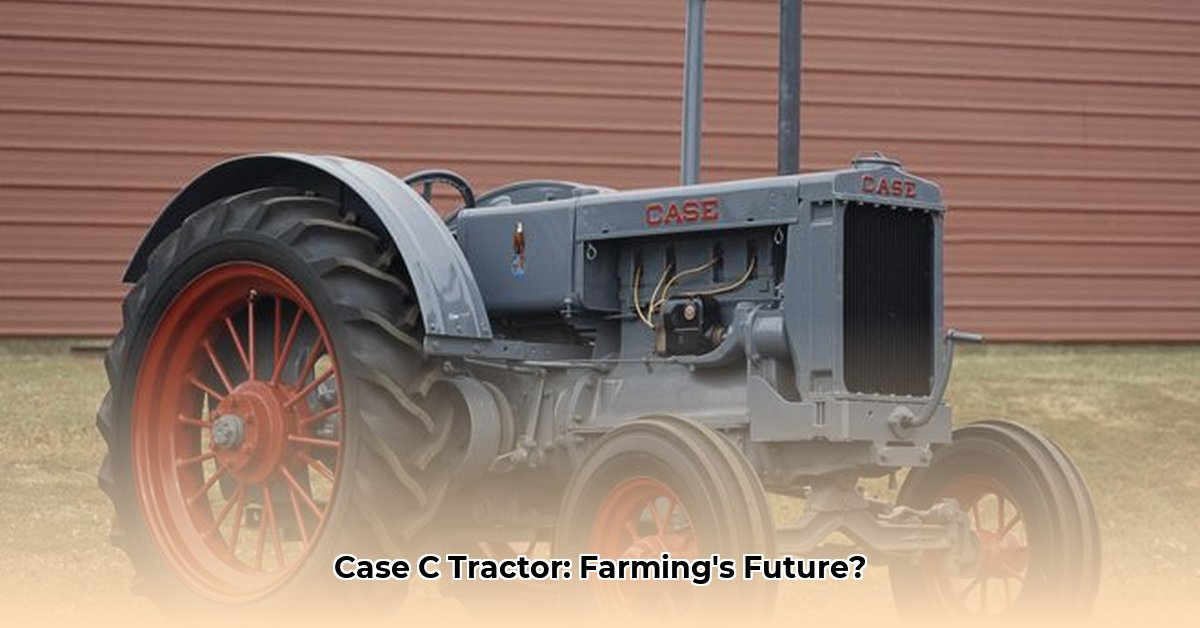
The Case C Legacy: A Look Back at Sustainable Farming's Workhorse
The J.I. Case C tractor series holds a significant place in agricultural history. These robust machines, often described as the "workhorses" of their time, were renowned for their reliability and simplicity. Their straightforward design prioritized durability and affordability, making them accessible to a wide range of farmers. However, compared to modern counterparts, their capabilities were more limited. Horsepower was comparatively low (ranging from approximately 17 to 21.4 drawbar horsepower), and transmissions were basic, typically 3-speed systems. While lacking the advanced features of contemporary tractors, their ease of maintenance and repair contributed to their longevity and widespread adoption. Images of these classic tractors evoke a sense of nostalgia, representing a time when farming practices were often more labor-intensive. [Data unavailable on precise fuel efficiency and emission standards for this era, highlighting a need for further historical research.] How did these limitations affect their impact on sustainable agriculture? The answer lies in understanding the technological constraints and farming practices of their time. For more information on specific Case models, see this helpful resource.
The Modern Marvel: Case IH Farmall Compact C Series – Sustainability Redefined
The Case IH Farmall Compact C series represents a dramatic evolution from its predecessors. This modern iteration prioritizes efficiency, comfort, and, crucially, sustainability. The leap forward is comparable to the difference between a horse-drawn plow and a GPS-guided combine harvester. Key improvements directly address the challenges of modern sustainable agriculture:
- Fuel Efficiency: Modern, more efficient engines deliver increased horsepower while consuming less fuel, minimizing operating costs and reducing the carbon footprint.
- Reduced Emissions: The integration of advanced emission control technologies (meeting Tier 4 B/Final standards) significantly lowers harmful exhaust emissions, contributing to cleaner air and a more sustainable environment.
- Ergonomics: Enhanced ergonomics—features designed for operator comfort—reduce fatigue, leading to safer, more productive workdays and contribute to overall fuel efficiency.
How significant is this leap in efficiency? While precise fuel consumption data for a direct comparison remains unavailable and requires further investigation, anecdotal evidence from farmers and industry experts strongly suggests a substantial improvement.
Comparative Analysis: A Head-to-Head Look at Case C Tractors Through Time
To facilitate an informed decision, a direct comparison of key specifications is essential. The following table highlights the significant differences between the J.I. Case C series and the Case IH Farmall Compact C series:
| Feature | J.I. Case C Series (Historical) | Case IH Farmall Compact C Series | Notes |
|---|---|---|---|
| Horsepower | Varies (Generally 17-21.4 hp drawbar) | 35-55 hp | Specific models within each series will have varied specifications. |
| Transmission Type | Typically 3-speed manual | 12x12, 16x16, or 3-range hydrostatic | Significant advancement in transmission technology for improved efficiency. |
| Loader Lifting Capacity | Approximately 1808 lbs | Approximately 2756 lbs | Substantial increase in lifting capacity for handling heavier loads. |
| Fuel Efficiency | Data unavailable | Improved (precise data needed) | Further research is required for a precise quantitative comparison. |
| Emissions Standards | N/A | Tier 4 B/Final | A major advancement in reducing environmental impact. |
The data clearly showcases a significant increase in power and lifting capacity in the Farmall C series. The advanced transmission systems offer greater efficiency and operational ease. While fuel efficiency is demonstrably improved, quantifying this difference requires further research to obtain precise fuel consumption data for both series.
Sustainability: Beyond Lower Emissions – The Economic and Environmental Impacts
The Farmall C series' sustainability goes beyond just lower emissions. The precision capabilities reduce fuel waste and the need for manual labor, promoting "smarter" farming. While the initial investment might be higher, long-term cost savings are realized through increased efficiency and reduced fuel consumption. This translates to both economic and environmental benefits. Is the overall investment in environmental protection offset by economic gains? That's a crucial discussion point for potential buyers.
Actionable Insights: A Roadmap for Choosing the Right Tractor
The decision of which tractor to choose depends heavily on individual circumstances and needs. This section outlines actionable steps for different stakeholders:
For Small-Scale Farmers: Upgrading to a Farmall C might be a worthwhile long-term investment, particularly considering potential gains in efficiency, reduced emissions, and long-term cost savings. Explore financing options and available government subsidies for sustainable farming equipment. A thorough ROI (Return on Investment) calculation is key.
For Equipment Dealers: Promoting the Farmall C's sustainability features is vital in today's market. Invest in training programs for sales staff to emphasize these benefits and effectively address customer inquiries.
For Researchers: Comprehensive lifecycle assessments of both tractor models are crucial to fully understand their environmental impacts across their entire lifespan, encompassing manufacturing, operation, and disposal.
For Policy Makers: Incentivizing the adoption of sustainable farming technologies through financial incentives and policies promoting environmentally responsible agriculture is critical.
Navigating the Challenges: A Realistic Assessment
While the Farmall C series offers significant advantages, it's crucial to acknowledge potential drawbacks. The initial cost is considerably higher than an older J.I. Case C tractor, and maintenance considerations are important. However, various financing options can mitigate the high upfront cost. Furthermore, the increased reliance on technology should be balanced against the long-term benefits in efficiency and sustainability.
The evolution from the J.I. Case C to the Case IH Farmall Compact C reflects a crucial trend in modern agriculture: continuous improvement driven by both technological advancements and the increasing demand for sustainable farming practices. The Farmall C represents a significant step toward a greener and more efficient future in agriculture, even as older models retain a place in agricultural history.